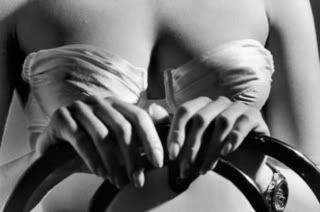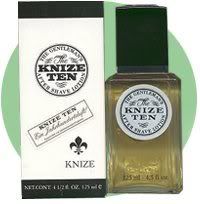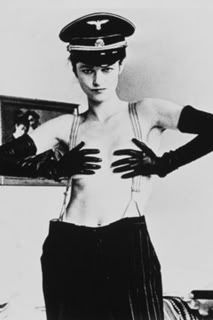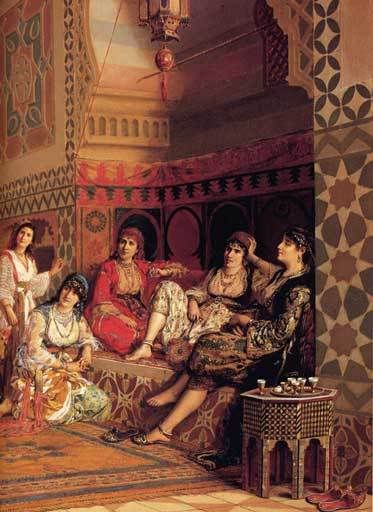
What is it that links orange blossom to sexy aromas? Many of the interpretations of this note in perfumery take advantage of the naturally lush and sexual aroma of the blossoms and in our investigation of this subject we have come up against many interesting tidbits of information that might help elucidate why and how.
The use of perfume as an enhancement and not concealement of genitalia and hormone odours has been in practice till ancient times. It was the knowledgable ancient Egyptian women who used
Kyphi rolled in miniscule balls, placed in the vulva. They also used amber mixes and civet. The Hindus also used the smell of female genitalia as a classification point for women, in which no one is left unappareciated. In Shakespeare's times it was common for men and women to offer apples to the object of their affection that had been saturated in the sweat of the armpit. That was meant to be a signification of desire and perhaps an early attempt at judging whether the prospective lover's
pheromones would intermingle well with their sensibilities.
In the
Memoirs of Casanova, we come across an observation that there is a hidden something in the air of a lover's bedroom that would make it very easy to choose between it and Heaven itself. So much is the infatuation that a beloved's body produces in the soul. And on that note who can forget the infamous epistle of Napoléon to Joséphine when he passionately wrote to her: "Je réviens en trois jours; ne te lave pas!" (I return in three days, don't wash yourself)
Anais Nin and Henry Miller were no strangers to the alchemical nature of the odorata sexualis of a lover that can be enhanced by perfume and Nin's personal choice of Caron's
Narcisse Noir (a fragrance rich in orange blossom)and Guerlain's
Mitsouko shows an appreciation for blends that enhance a person's natural sexual aroma. Beaudelaire, Flaubert (who kept the mittens of his mistress on a drawer for sniffing purposes), Goethe and Reiner Maria Rilke are also literature figures that occupied themselves with the fragrant nature of seduction.
Even in our more pedestrian times the allure of the erotic has been used to great effect in advertising. From
Schocking by Schiaparelli to
Ambre Sultan by Lutens to
Boudoir by Westwood, many perfumes have claimed to capture in fragrant droplets the odorata sexualis of a woman for seduction purposes. Last olfactory example of this being Tom Ford' attempt at it when he proclaimed that his last fragrance
Black Orchid was supposed to smell of a man's crotch. I think not, but hey, you have been warned!
Of course like a plethora of things in life much of the effect of something relies on context. Meaning that leaving youself unwashed would not shill your charms to potential lovers necessarily if some particular smell is not pleasant to them or the sweat is rank. It all has to do with delicate proportion and adjustment. In a fascinating experiment by Paul Jellineck, recounted in
Essence and Alchemy, people had been asked to smell versions of well-known frags such as
Quelques Fleurs by Houbigant and a traditional eau de Cologne with and without the addition of neroli. In the former case the neroli just mingled with the other floral substances adding a fresh note and balancing them, whereas in the latter it seemed sultry and rich and therefore erotically nuanced. This goes to show that although there is a clear cut path to lust and sexuality, eroticism in perfume as in any other area is complex and subtle, dependent on context and associations that need a delicate hand in placing them there.
So how orange blossom is linked to all these exciting observations? Let me shock you a bit in case you were unaware of the fact. Orange Blossom (as well as jasmine) is filled with
the fascinating indole.
According to Encyclopedia Brittanica:
Indole, also called Benzopyrrole, is a heterocyclic organic compound occurring in some flower oils, such as jasmine and orange blossom, in coal tar, and in fecal matter. It is used in perfumery and in making tryptophan, an essential amino acid, and indoleacetic acid (heteroauxin), a hormone that promotes the development of roots in plant cuttings. First isolated in 1866, it has the molecular formula C8H7N.
It is this base ingredient that is so abundant in white florals -among them orange blossom to a moderate degree- that apparently gives a nod to the human aspect of our existence and reminds us of our primeval objects in life: to have sex and procreate. In this context it is no accident that orange blossom is traditionally used in wedding wreaths, as discussed yesterday.
Therefore if a catcall to carnality is your objective, yet you want to go about it more discreetly than resorting to civet (the pungent extract of the anal glands of a species of the
Viverridae shaped like a small fox and native to Abysinnia, Java, Borneo, Sumatra and Bengal and farmed in Ethiopia for perfume purposes), orange blossom can be a Heaven sent destined to confine you in the abyss of Hell.
For this purpose there is no better choice than the rich, sultry, lush and totally feminine with a capital F
Fleurs d'oranger by Serge Lutens. Luckily a part of the export line, but also available in a beautiful
bell jar in the exclusive Palais Royal for Shiseido line of scents, it is the essence of classy sexiness captured in a bottle. Like a woman of mature wiles sitting under an orange grove contemplating serious romance and seduction it is multi-nuanced with precious essences of white jasmine and indian tuberose that enhance the indolic aspect to magnificent proportions, laced with the sprinkle of fiery spice like cumin and nutmeg rolled in tangy citrus peel, all the while exuding aromas of muskiness and floralncy in alrernative overlappings like the tongue of a skillful lover. The inclusion of rose and hibiscus seeds consolidates the velours aspect of a base that never really leaves the skin, reminding you of happy romance even after it is just a distant memory in the farthest corners of your mind.
Next post will tackle another aspect of orange blossom.
Art photography by Spyros Panayiotopoulos, courtesy of eikastikon.gr




.jpg)













